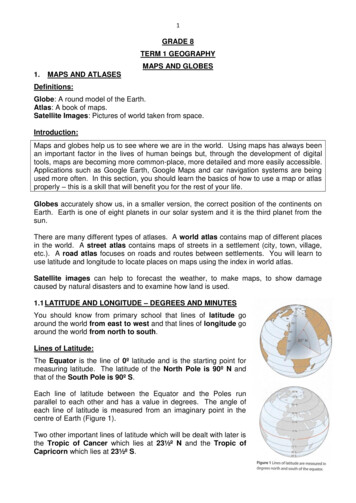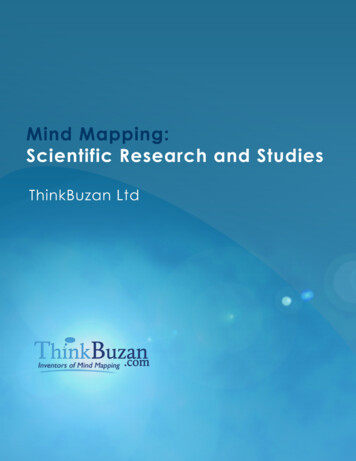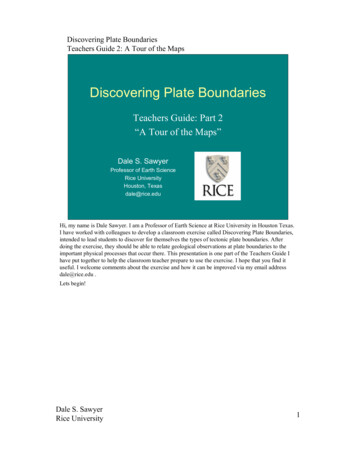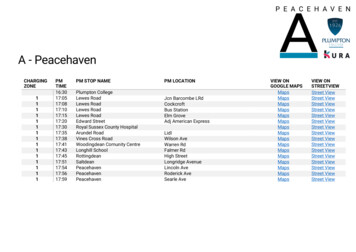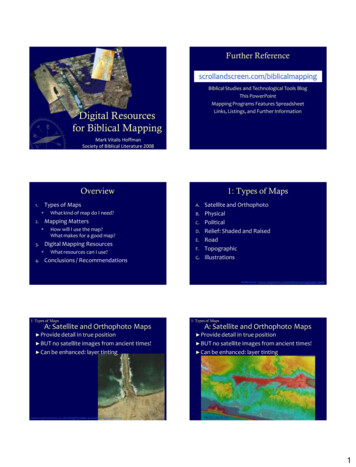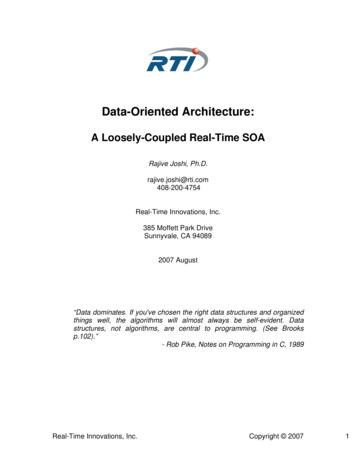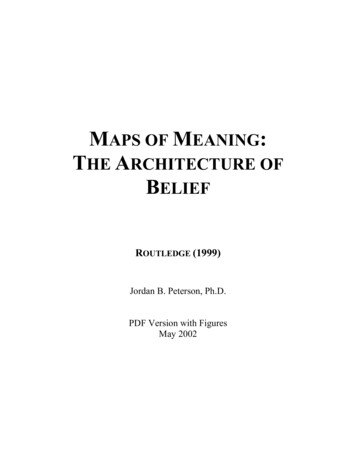
Transcription
MAPS OF MEANING:THE ARCHITECTURE OFBELIEFROUTLEDGE (1999)Jordan B. Peterson, Ph.D.PDF Version with FiguresMay 2002
2
PREFACE: DESCENSUS AD INFEROS 7CHAPTER 1: MAPS OF EXPERIENCE: OBJECT AND MEANING 15CHAPTER 2: MAPS OF MEANING: THREE LEVELS OF ANALSIS 282.1. Normal and Revolutionary Life: Two Prosaic Stories 292.1.1. Normal Life 312.1.2. Revolutionary Life 352.2. Neuropsychological Function: The Nature of the Mind2.2.1. The Valence of Things2.2.2. Unexplored Territory: Phenomenology and Neuropsychology2.2.3. Exploration: Phenomenology and Neuropsychology2.2.4. Explored Territory: Phenomenology and Neuropsychology37384449592.3. Mythological Representation: The Constituent Elements of Experience 802.3.1. Introduction 812.3.2. The Enuma elish: A Comprehensive Exemplar of Narrative Categorization 932.3.3. The Dragon of Primordial Chaos 1152.3.4. The Great Mother: Images of the Unknown, or Unexplored Territory 1242.3.5. The Divine Son: Images of the Knower, the Exploratory Process 1452.3.6. The Great Father: Images of the Known, or Explored Territory 153CHAPTER 3: APPRENTICESHIP AND ENCULTURATION: ADOPTION OF A SHARED MAP 175CHAPTER 4: THE APPEARANCE OF ANOMALY: CHALLENGE TO THE SHARED MAP 1884.1. Introduction: The Paradigmatic Structure of the Known 1894.2. Particular Forms of Anomaly: The Strange, the Stranger, the Strange Idea & the Revolutionary Hero 1974.2.1. The Strange 1974.2.2. The Stranger 1994.2.3. The Strange Idea 2014.2.4. The Revolutionary Hero 2164.3. The Rise of Self-Reference, and the Permanent Contamination of Anomaly with Death 225CHAPTER 5: THE HOSTILE BROTHERS: ARCHETYPES OF RESPONSE TO THE UNKNOWN 2445.1. Introduction: The Hero and the Adversary 2445.2. The Adversary: Emergence, Development and Representation 2475.2.1. The Adversary in Action: Voluntary Degradation of the Map of Meaning 2565.2.2. The Adversary In Action: A Twentieth Century Allegory 2695.3. Heroic Adaptation: Voluntary Reconstruction of the Map of Meaning5.3.1. The Creative Illness and the Hero5.3.2. The Alchemical Procedure and the Philosopher’s Stone5.3.2.1. Introductory Note5.3.2.1.1. Part One5.3.2.1.2. Part Two5.3.2.2. The “Material World” as Archaic “Locus of the Unknown”5.3.2.3. Episodic Representation in Medieval Christendom3.3.2.4. The Prima Materia5.3.2.5. The King of Order5.3.2.6. The Queen of Chaos5.3.2.7. The Peregrination5.3.2.8. The 5.4. Conclusion: The Divinity of Interest 3465.4.1. Introduction 3475.4.2. The Divinity of Interest 3533
Figure 1: The Domain and Constituent Elements of the KnownFigure 2: The Metamythological Cycle of the WayFigure 3: Normal AdaptationFigure 4: Revolutionary AdaptationFigure 5: The Ambivalent Nature of NoveltyFigure 6: Emergence of "Normal Novelty" in the Course of Goal-Directed BehaviorFigure 7: Emergence of "Revolutionary Novelty" in the Course of Goal-Directed BehaviorFigure 8: The Motor and Sensory Units of the BrainFigure 9: The Regeneration of Stability from the Domain of ChaosFigure 10: The Motor HomunculusFigure 11: The Twin Cerebral Hemispheres and their FunctionsFigure 12: The Multiple Structure of MemoryFigure 13: Abstraction of Wisdom, and the Relationship of Such Abstraction to MemoryFigure 14: Conceptual Transformation of the Means/Ends Relationship from Static to DynamicFigure 15: Bounded RevolutionFigure 16: Nested Stories, Processes of Generation, Multiple Memory SystemsFigure 17: The Constituent Elements of ExperienceFigure 18: The Positive Constituent Elements of Experience, PersonifiedFigure 19: The Birth of the World of GodsFigure 20: The "Death" of Apsu, and the (Re)Emergence of Tiamat as ThreatFigure 21: "World" of Gods: Hierarchical OrganizationFigure 22: The Enuma elish in Schematic RepresentationFigure 23: The Battle between Osiris and Seth in the Domain of OrderFigure 24: The Involuntary Descent and Disintegration of OsirisFigure 25: The Birth and Return of Horus, Divine Son of Order and ChaoFigure 26: Voluntary Encounter with the UnderworldFigure 27: Ascent, and Reintegration of the FatherFigure 28: The Constituent Elements of Experience as Personality, Territory and ProcessFigure 29: The Uroboros - Precosmogonic Dragon of ChaosFigure 30: The Birth of the World ParentsFigure 31: The Constituent Elements of the World, in Dynamic RelationshipFigure 32: Novelty, the Great Mother, as Daughter of the UroborosFigure 33: The Spontaneous Personification of Unexplored TerritoryFigure 34: Unexplored Territory as Destructive MotherFigure 35: Unexplored Territory as Creative MotherFigure 36: The "Heavenly Genealogy" of the Destructive and Creative MothersFigure 37: The Exploratory Hero as Son of the Heavenly MotherFigure 38: The Metamythology of the Way, revisitedFigure 39: Castle, Hero, Serpent and Virgin: St. George and the DragonFigure 40: The Process of Exploration and Update, as the Meta-Goal of ExistenceFigure 41: Order, the Great Father, as Son of the UroborosFigure 42: Explored Territory as Orderly, Protective FatherFigure 43: Explored Territory as Tyrannical FatherFigure 44: The "Heavenly Genealogy" of the Tyrannical and Protective FathersFigure 45: The Exploratory Hero as Son of the Great FatherFigure 46: The "Death" and "Rebirth" of the Adolescent InitiateFigure 47: The Paradigmatic Structure of the KnownFigure 48: The Known: Nested Groups and IndividualsFigure 49: The Fragmentary Representation of "Procedure and Custom" in Image and WordFigure 50: The "Dual Death" of the Revolutionary HeroFigure 51: The Crucified Redeemer as Dragon of Chaos and TransformationFigure 52: The Socially Destructive and Redemptive "Journey" of the Revolutionary 01511671681711721731801931942012162212224
Figure 53: The (Voluntary) Descent of the BuddhaFigure 54: The World-Tree as Bridge between "Heaven" and "Hell"Figure 55: The World-Tree and the Constituent Elements of ExperienceFigure 56: Genesis and DescentFigure 57: The Devil as Aerial Spirit and Ungodly IntellectFigure 58: The Vicious Circle of the AdversaryFigure 59: The Constituent Elements of Existence, reprise.Figure 60: The Emergence of Christ from Group Identity and ChaosFigure 61: World-Tree of Death and RedemptionFigure 62: The Alchemical Opus as "Normal Story"Figure 63: The Alchemical Opus as "Revolutionary Story"Figure 64: The Wolf as prima materia, Devouring the Dead KingFigure 65: Dragon of Chaos as "Birthplace" of Christ and the LapisFigure 66: The Alchemical Opus as Myth of RedemptionFigure 67: The Restitution of [Christ] the Mystic Apple to the Tree of KnowledgeFigure 68: The Eternal Return of the 3453583595
I will utter things which have been kept secret from the foundation of the world. (Matthew 13:35)6
PREFACE: DESCENSUS AD INFEROSSomething we cannot see protects us from something we do not understand. The thing we cannot see isculture, in its intrapsychic or internal manifestation. The thing we do not understand is the chaos that gaverise to culture. If the structure of culture is disrupted, unwittingly, chaos returns. We will do anything –anything – to defend ourselves against that return.“. the very fact that a general problem has gripped and assimilated the whole of a person is a guaranteethat the speaker has really experienced it, and perhaps gained something from his sufferings. He will thenreflect the problem for us in his personal life and thereby show us a truth.” 1I was raised under the protective auspices, so to speak, of the Christian Church. This does not mean that myfamily was explicitly religious. I attended conservative Protestant services during childhood with mymother, but she was not a dogmatic or authoritarian believer, and we never discussed religious issues athome. My father appeared essentially agnostic, at least in the traditional sense. He refused to even set footin a church, except during weddings and funerals. Nonetheless, the historical remnants of Christianmorality permeated our household, conditioning our expectations and interpersonal responses, in the mostintimate of manners. When I grew up, after all, most people still attended church; furthermore, all the rulesand expectations that made up middle-class society were Judeo-Christian in nature. Even the increasingnumber of those who could not tolerate formal ritual and belief still implicitly accepted – still acted out –the rules that made up the Christian game.When I was twelve or so my mother enrolled me in confirmation classes, which served as introductionto adult membership in the Church. I did not like attending. I did not like the attitude of my overtlyreligious classmates (who were few in number), and did not desire their lack of social standing. I did notlike the school-like atmosphere of the confirmation classes. More importantly, however, I could notswallow what I was being taught. I asked the minister, at one point, how he reconciled the story of Genesiswith the creation theories of modern science. He had not undertaken such a reconciliation; furthermore, heseemed more convinced, in his heart, of the evolutionary viewpoint. I was looking for an excuse to leave,anyway – and that was the last straw. Religion was for the ignorant, weak and superstitious. I stoppedattending church, and joined the modern world.Although I had grown up in a “Christian” environment – and had a successful and happy childhood, inat least partial consequence – I was more than willing to throw aside the structure that had fostered me. Noone really opposed my rebellious efforts, either, in church or at home – in part because those who weredeeply religious (or who might have wanted to be) had no intellectually acceptable counter-arguments attheir disposal. After all, many of the basic tenets of Christian belief were incomprehensible, if not clearlyabsurd. The virgin birth was an impossibility; likewise, the notion that someone could rise from the dead.Did my act of rebellion precipitate a familial or a social crisis? No. My actions were so predictable, in asense, that they upset no one, with the exception of my mother (and even she was soon resigned to theinevitable). The other members of the church – my “community” – had become absolutely habituated to theincreasingly-frequent act of defection, and did not even notice.Did my act of rebellion upset me, personally? Only in a manner I was not able to perceive, until manyyears later. I developed a premature concern with large-scale political and social issues, at about the sametime I quit attending church. Why were some countries, some people, rich, happy and successful, whileothers were doomed to misery? Why were the forces of NATO and the Soviet Union continually at eachother’s throats? How was it possible for people to act the way the Nazis had, during World War Two?Underlying these specific considerations was a broader, but at the time ill-conceptualized question: how didevil – particularly group-fostered evil – come to play its role in the world?I abandoned the traditions that supported me, at about the same time I left childhood. This meant that Ihad no broader socially constructed “philosophy” at hand, to aid my understanding, as I became aware ofthe existential problems that accompany maturity. The final consequences of that lack took years to become7
fully manifest. In the meantime, however, my nascent concern with questions of moral justice foundimmediate resolution. I started working as a volunteer for a mildly socialist political party, and adopted theparty line.Economic injustice was at the root of all evil, as far as I was concerned. Such injustice could berectified, as a consequence of the re-arrangement of social organizations. I could play a part in thatadmirable revolution, carrying out my ideological beliefs. Doubt vanished; my role was clear. Lookingback, I am amazed at how stereotypical my actions – reactions – really were. I could not rationally acceptthe premises of religion – not as I understood them. I turned, in consequence, to dreams of political utopia,and personal power. The same ideological trap caught millions of others, in recent centuries – caught andkilled millions.When I was seventeen I left the town I grew up in. I moved nearby and attended a small college, whichoffered the first two years of undergraduate education. I involved myself there in university politics –which were more-or-less left wing at that time – and was elected to the college board of governors. Theboard was composed of politically and ideologically conservative people: lawyers, doctors, andbusinessmen. They were all well (or at least practically) educated, pragmatic, confident, outspoken; theyhad all accomplished something worthwhile and difficult. I could not help but admire them, even though Idid not share their political stance. I found the fact of my admiration unsettling.I had attended several left-wing party congresses, as a student politician and active party-worker. Ihoped to emulate the socialist leaders. The left wing had a long and honorable history in Canada, andattracted some truly competent and caring people. However, I could not generate much respect for thenumerous low-level party activists I encountered at these meetings. They seemed to live to complain: hadno career, frequently; no family, no completed education – nothing but ideology. They were peevish,irritable, and little, in every sense of the word. I was faced, in consequence, with the mirror image of theproblem I encountered on the college board: I could not admire many of the individuals who believed thesame things I did. This additional complication furthered my existential confusion.My college roommate, an insightful cynic, expressed skepticism regarding my ideological beliefs. Hetold me that the world could not be completely encapsulated within the boundaries of socialist philosophy. Ihad more or less come to this conclusion on my own, but had not admitted so much in words. Soonafterward, however, I read George Orwell’s Road to Wigan Pier. This book finally undermined me – notonly my socialist ideology, but my faith in ideological stances themselves. In the famous essay concludingthat book (written for – and much to the dismay of – the British Left Book Club) Orwell described the greatflaw of socialism, and the reason for its frequent failure to attract and maintain democratic power (at leastin Britain). Orwell said, essentially, that socialists did not really like the poor. They merely hated the rich.2His idea struck home instantly. Socialist ideology served to mask resentment and hatred, bred by failure.Many of the party activists I had encountered were using the ideals of social justice, to rationalize theirpursuit of personal revenge.Whose fault was it, that I was poor or uneducated and unadmired? Obviously – the fault of the rich,well-schooled and respected. How convenient, then, that the demands of revenge and abstract justicedovetailed! It was only right to obtain recompense from those more fortunate than me.Of course, my socialist colleagues and I weren’t out to hurt anyone – quite the reverse. We were out toimprove things – but we were going to start with other people. I came to see the temptation in this logic, theobvious flaw, the danger – but could also see that it did not exclusively characterize socialism. Anyone whowas out to change the world by changing others was to be regarded with suspicion. The temptations of sucha position were too great to be resisted.It was not socialist ideology that posed the problem, then – but ideology, as such. Ideology divided theworld up simplistically into those who thought and acted properly, and those who did not. Ideology enabledthe believer to hide from his own unpleasant and inadmissible fantasies and wishes. Such realizations upsetmy beliefs (even my faith in beliefs), and the plans I had formulated, as a consequence of these beliefs. Icould no longer tell who was good and who was bad, so to speak – I no longer knew who to support, orwho to fight. This state of affairs proved very troublesome, pragmatically as well as philosophically. Iwanted to become a corporate lawyer – had written the Law School Admissions Test, had taken two yearsof appropriate preliminary courses. I wanted to learn the ways of my enemies, and embark on a political8
career. This plan disintegrated. The world obviously did not need another lawyer, and I no longer believedthat I knew enough to masquerade as a leader.I became simultaneously disenchanted with the study of political science, my original undergraduatemajor. I had adopted that discipline so I could learn more about the structure of human beliefs (and for thepractical, career-oriented reasons described previously). It remained very interesting to me when I was atjunior college, where I was introduced to the history of political philosophy. When I moved to the maincampus at the University of Alberta, however, my interest disappeared. I was taught that people weremotivated by rational forces; that human beliefs and actions were determined by economic pressures. Thisdid not seem sufficient explanation. I could not believe (and still do not) that commodities – “naturalresources,” for example – had intrinsic and self-evident value. In the absence of such value, the worth ofthings had to be socially or culturally (or even individually) determined. This act of determination appearedto me moral – appeared to me to be a consequence of the moral philosophy adopted by the society, cultureor person in question. What people valued, economically, merely reflected what they believed to beimportant. This meant that real motivation had to lie in the domain of value, of morality. The politicalscientists I studied with did not see this, or did not think it was relevant.My religious convictions, ill-formed to begin with, disappeared when I was very young. My confidencein socialism (that is, in political utopia) vanished when I realized that the world was not merely a place ofeconomics. My faith in ideology departed, when I began to see that ideological identification itself posed aprofound and mysterious problem. I could not accept the theoretical explanations my chosen field of studyhad to offer, and no longer had any practical reasons to continue in my original direction. I finished mythree-year bachelor’s degree, and left university. All my beliefs – which had lent order to the chaos of myexistence, at least temporarily – had proved illusory; I could no longer see the sense in things. I was castadrift; I did not know what to do, or what to think.But what of others? Was there evidence anywhere that the problems I now faced had been solved, byanyone, in any acceptable manner? The customary behavior and attitudes of my friends and familymembers offered no solution. The people I knew well were no more resolutely goal-directed or satisfiedthan I was. Their beliefs and modes of being seemed merely to disguise frequent doubt and profounddisquietude. More disturbingly, on the more general plane, something truly insane was taking place. Thegreat societies of the world were feverishly constructing a nuclear machine, with unimaginably destructivecapabilities. Someone or something was making terrible plans. Why? Theoretically normal and welladapted people were going about their business prosaically, as if nothing were the matter. Why weren’tthey disturbed? Weren’t they paying attention? Wasn’t I?My concern with the general social and political insanity and evil of the world – sublimated bytemporary infatuation with utopian socialism and political machination – returned with a vengeance. Themysterious fact of the cold war increasingly occupied the forefront of my consciousness. How could thingshave come to such a point?History is just a madhouseit’s turned over all the stonesand its very careful readingleaves you little that’s unknownI couldn’t understand the nuclear race: what could possibly be worth risking annihilation – not merely ofthe present, but of the past and the future? What could possibly justify the threat of total destruction?Bereft of solutions, I had at least been granted the gift of a problem.I returned to university and began to study psychology. I visited a maximum security prison on theoutskirts of Edmonton, under the supervision of an eccentric adjunct professor at the University of Alberta.His primary job was the psychological care of convicts. The prison was full of murderers, rapists, andarmed robbers. I ended up in the gym, near the weight room, on my first reconnaissance. I was wearing along wool cape, circa 1890, which I had bought in Portugal, and a pair of tall leather boots. Thepsychologist who was accompanying me disappeared, unexpectedly, and left me alone. Soon I wassurrounded by shoddy men, some of whom were extremely large and tough-looking. One in particularstands out in my memory. He was exceptionally muscular, and tattooed over his bare chest. He had a9
vicious scar running down the middle of his body, from his collarbone to his midsection. Maybe he hadsurvived open-heart surgery. Or maybe it was an ax wound. The injury would have killed a lesser man,anyway – someone like me.Some of the prisoners, who weren’t dressed particularly well, offered to trade their clothes for mine.This did not strike me as a great bargain, but I wasn’t sure how to refuse. Fate rescued me, in the form of ashort, skinny, bearded man. He came up to me – said that the psychologist had sent him – and asked me toaccompany him. He was only one person, and many others (much larger) currently surrounded me and mycape. So I took him at his word. He led me outside the gym doors, and out into the prison yard, talkingquietly but reasonably about something innocuous (I don’t recall what) all the while. I kept glancing backhopefully at the open doors behind us as we got further and further away. Finally my supervisor appeared,and motioned me back. We left the bearded prisoner, and went to a private office. The psychologist told methat the harmless-appearing little man who had escorted me out of the gym had murdered two policemen, incold blood, after he had forced them to dig their own graves. One of the policemen had little children, andhad begged for his life, on their behalf, while he was digging – at least according to the murderer’s owntestimony.This really shocked me.I had read about this sort of event, of course – but it had never been made real for me. I had never metsomeone even tangentially affected by something like this; had certainly not encountered anyone who hadactually done something so terrible. How could the man I had talked to – who was so apparently normal(and so seemingly inconsequential) – have done such an awful thing?Some of the courses I was attending at this time were taught in large lecture theaters, where the studentswere seated in descending rows, row after row. In one of these courses – Introduction to ClinicalPsychology, appropriately enough – I experienced a recurrent compulsion. I would take my seat behindsome unwitting individual and listen to the professor speak. At some point during the lecture, I wouldunfailingly feel the urge to stab the point of my pen into the neck of the person in front of me. This impulsewas not overwhelming – luckily – but it was powerful enough to disturb me. What sort of terrible personwould have an impulse like that? Not me. I had never been aggressive. I had been smaller and younger thanmy classmates, for most of my life.I went back to the prison, a month or so after my first visit. During my absence, two prisoners hadattacked a third, a suspected informer. They held or tied him down and pulverized one of his legs with alead pipe. I was taken aback, once again, but this time I tried something different. I tried to imagine, reallyimagine, what I would have to be like to do such a thing. I concentrated on this task for days and days – andexperienced a frightening revelation. The truly appalling aspect of such atrocity did not lie in itsimpossibility or remoteness, as I had naively assumed, but in its ease. I was not much different from theviolent prisoners – not qualitatively different. I could do what they could do (although I hadn’t).This discovery truly upset me. I was not who I thought I was. Surprisingly, however, the desire to stabsomeone with my pen disappeared. In retrospect, I would say that the behavioral urge had manifested itselfin explicit knowledge – had been translated from emotion and image to concrete realization – and had nofurther “reason” to exist. The “impulse” had only occurred, because of the question I was attempting toanswer: “how can men do terrible things to one another?” I meant other men, of course – bad men – but Ihad still asked the question. There was no reason for me to assume that I would receive a predictable orpersonally meaningless answer.At the same time, something odd was happening to my ability to converse. I had always enjoyedengaging in arguments, regardless of topic. I regarded them as a sort of game (not that this is in any wayunique). Suddenly, however, I couldn’t talk – more accurately, I couldn’t stand listening to myself talk. Istarted to hear a “voice” inside my head, commenting on my opinions. Every time I said something, it saidsomething – something critical. The voice employed a standard refrain, delivered in a somewhat bored andmatter-of-fact tone:You don’t believe that.That isn’t true.You don’t believe that.That isn’t true.10
The “voice” applied such comments to almost every phrase I spoke.I couldn’t understand what to make of this. I knew the source of the commentary was part of me – Iwasn’t schizophrenic – but this knowledge only increased my confusion. Which part, precisely, was me –the talking part, or the criticizing part? If it was the talking part, then what was the criticizing part? If itwas the criticizing part – well, then: how could virtually everything I said be untrue? In my ignorance andconfusion, I decided to experiment. I tried only to say things that my internal reviewer would passunchallenged. This meant that I really had to listen to what I was saying, that I spoke much less often, andthat I would frequently stop, midway through a sentence, feel embarrassed, and reformulate my thoughts. Isoon noticed that I felt much less agitated and more confident when I only said things that the “voice” didnot object to. This came as a definite relief. My experiment had been a success; I was the criticizing part.Nonetheless, it took me a long time to reconcile myself to the idea that almost all my thoughts weren’t real,weren’t true – or, at least, weren’t mine.All the things I “believed” were things I thought sounded good, admirable, respectable, courageous.They weren’t my things, however – I had stolen them. Most of them I had taken from books. Having“understood” them, abstractly, I presumed I had a right to them – presumed that I could adopt them, as ifthey were mine: presumed that they were me. My head was stuffed full of the ideas of others; stuffed full ofarguments I could not logically refute. I did not know then that an irrefutable argument is not necessarilytrue, nor that the right to identify with certain ideas had to be earned.I read something by Carl Jung, at about this point, that helped me understand what I was experiencing. Itwas Jung who formulated the concept of persona: the mask that “feigned individuality.”3 Adoption of sucha mask, according to Jung, allowed each of us – and those around us – to believe that we were authentic.Jung said:“When we analyse the persona we strip off the mask, and discover that what seemed to be individual isat bottom collective; in other words, that the persona was only a mask of the collective psyche.Fundamentally the persona is nothing real: it is a compromise between individual and society as to whata man should appear to be. He takes a name, earns a title, exercises a function, he is this or that. In acertain sense all this is real, yet in relation to the essential individuality of the person concerned it is onlya secondary reality, a compromise formation, in making which others often have a greater share than he.The persona is a semblance, a two-dimensional reality, to give it a nickname.”4Despite my verbal facility, I was not real. I found this painful to admit.I began to dream absolutely unbearable dreams. My dream life, up to this point, had been relativelyuneventful, as far as I can remember; furthermore, I have never had a particularly good visual imagination.Nonetheless, my dreams beca
Figure 1: The Domain and Constituent Elements of the Known 23 Figure 2: The Metamythological Cycle of the Way 25 Figure 3: Normal Adaptation 34 Figure 4: Revolutionary Adaptation 36 Figure 5: The Ambivalent Nature of Novelty 45 Figure 6: Emergence of "Normal Novelty" in the Course of Goal-Directed Behavior 46 Figure 7: Emergence of "Revolutionary Novelty" in the Course of Goal-Directed Behavior 47


